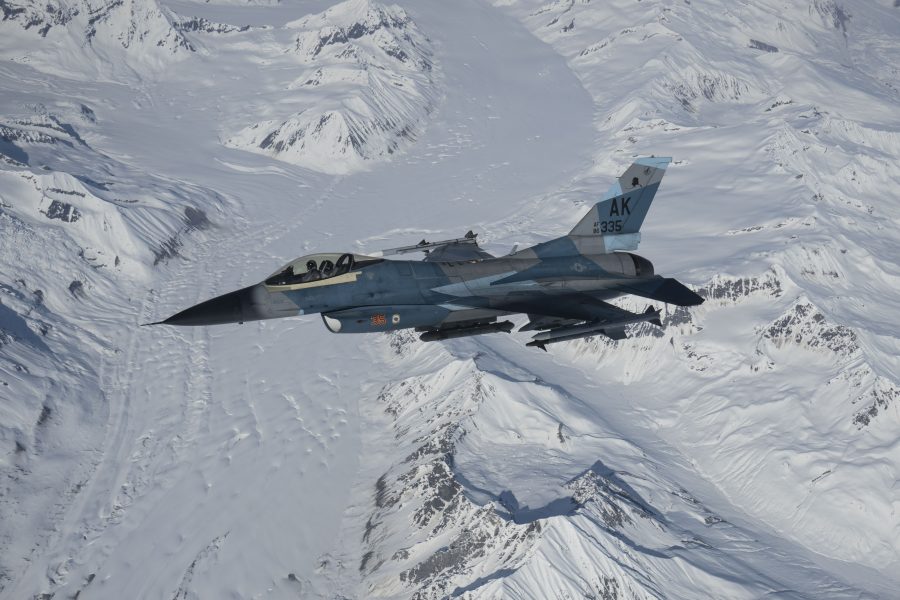In its updated Arctic Strategy released July 22, the Pentagon says it will take a “monitor-and-respond” approach to the region, as officials warned that more cooperation between China and Russia and the effects of climate change present growing challenges in the area.
The Arctic is “becoming a venue for strategic competition,” Defense Secretary Lloyd J. Austin III wrote. In response, the U.S. military must “enhance its Arctic capabilities.”
Melting ice is creating bigger shipping lanes and more access to the Arctic than ever before, Deputy Defense Secretary Kathleen H. Hicks told reporters. Meanwhile, Russia remains active even as its war in Ukraine rages on, and China has sought to assert itself as a “near-Arctic” nation.
“Although the vast majority of the Arctic is under the jurisdiction of sovereign states, the PRC seeks to promote the Arctic region as a ‘global commons’ in order to shift Arctic governance in its favor,” the strategy states, referring to the People’s Republic of China.
The strategy also notes that while Russia and China’s interests are not completely aligned, the war in Ukraine has pushed them closer together and they have upped their military cooperation in the Arctic specifically with more exercises.
“It’s very noticeable and concerning,” Hicks said.
Deputy assistant secretary of defense for Arctic and global resilience Iris A. Ferguson also noted that both Chinese and Russian warships have exercised off the coast of Alaska in recent months, with the U.S. keeping “a watchful eye.”
That watchful eye is in line for upgrades, however. The harsh conditions and the unique location of the Arctic make it challenging to keep up equipment and infrastructure, and DOD wants to maintain “robust domain awareness and intelligence, surveillance, and reconnaissance capabilities,” Hicks said.
Monitoring
To up domain awareness in the region, the strategy calls for the Pentagon to invest in new technologies like updated radars, new satellites, and better communications networks. Hicks also told reporters she is interested in developing new unmanned platforms to perform domain awareness missions so that humans don’t have to in the harsh conditions.
“You have to ensure that even those uncrewed systems are survivable long enough at least to endure or are so inexpensive that their attritable nature is still worth it for the mission you’re putting them on,” she said. “So that means a lot of research and development and testing, and that’s where we’re focused in this area; Looking at the possibilities of where uncrewed systems can bring value.”
Yet Ferguson noted that many of the same problems that affect manned systems in the Arctic could also plague drones.
“Where we can lean into remote platforms, it can make a lot of sense,” she said. “However, it’s really tricky to operate remote platforms due to weather and due to connectivity issues. And so that’s where we’re trying to lean is looking at how we can test and do some R&D around ensuring these platforms can can operate.”
Specifically, the strategy says the Pentagon will “maintain” its current investments in manned and unmanned ISR platforms for the Arctic, while conducting an “analysis of requirements for future unmanned platforms.”
Responding
To prepare to respond to a crisis in the Arctic, the Pentagon wants to keep conducting regular exercises and develop its “regional expertise.”
The strategy notes regular exercises with an Air Force presence like U.S. Indo-Pacific Command’s Northern Edge, Northern Command’s Noble Defender, and European Command’s Arctic Challenge as ways to build that expertise, in addition to operations such as “supporting NATO’s Air Policing mission in Iceland; and providing airlift and refueling capability to U.S. and appropriate Ally and partner aircraft in the Arctic region.”
Air Force leaders have emphasized the importance of improved training in the Arctic before. In 2023, Lt. Gen. David S. Nahom, head of Alaskan Command, cited the issue during AFA’s Air, Space, & Cyber Conference.
“We frankly don’t do a good job in terms of training. We’re not just training aircrew how to fly but [wanting] everyone in the command to learn how to fly. The conditions require for that. How we train and how we operate can be improved,” Nahom said.
Perhaps the Air Force’s most unique Arctic capability is its LC-130, equipped with skis to land on ice. The “Skibird” fleet has gotten some upgrades over the years, but some lawmakers are calling for the aircraft to be recapitalized after decades of use.
Beyond the LC-130, though, the Air Force has a strong presence near the Arctic with F-16 and F-35 fighters, KC-135 tankers, and HH-60 helicopters all at Eielson Air Force Base in Alaska—and the Pentagon strategy noted that fighter presence in particular will continue to grow.
“By the 2030s the United States and our Arctic Allies will operate over 250 advanced multirole combat aircraft that could be deployed for Arctic operations,” the document states.
“That’s another incredible statistic to show the alignment of our allies and partners,” said Ferguson, “that the majority of our Arctic allies will have the F-35.”


